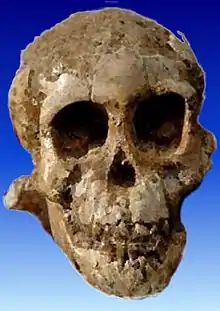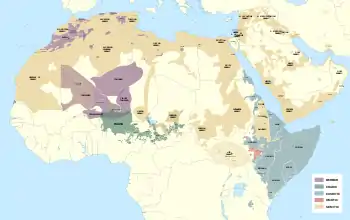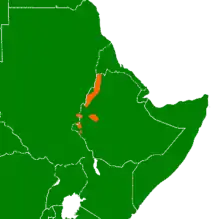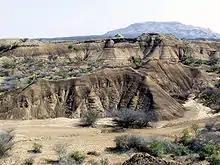Prehistoric Ethiopia
Ethiopia is considered the site of anatomically modern humans emergence.[1] Archeological discoveries in the country's sites garnered specific earliest fossils succession including the female hominin Australopithecus afarensis lived 3.2 million years ago, and Ardipithecus ramidus (4.4 million years ago). Human settlements in present-day Ethiopia began at least in Late Stone Age and agricultural revolution took place in the third millennium BC. Formulation of ethnolinguistic groups of Afroasiatic speakers (namely Semitic, Cushitic and Omotic) and Nilo-Saharan people shaped with new ethnic cultural and linguistic entity by the first millennium BC.
Prehistoric findings

One of the most prominent and precursor excavations in Ethiopia was conducted by Gerard Dekker in the site Melka Kunture in 1963. He uncovered a layered rock in north bank of flooded river, recording a fossil dating to 1.7 million years ago. French paleoanthropologist Jean Chavallion conducted systematic expedition in the area between 1965 and 1995. Homo erectus fossil aged 1.5 million–1.7 million years uncovered in Ethiopia, which has similar cranial fragments to early Homo sapiens.[2] The oldest of these local fossil finds, the Omo remains, were excavated in the southwestern Omo Kibish area and have been dated to the Middle Paleolithic, around 200,000 years ago.[1]
In 1974, American paleoanthropologist Donald Johnson exacuvated 3.2 million years ago early female hominin named Australopithecus afarensis nicknamed Lucy in a place Hadar in Awash Valley. Ethiopians refer the fossil "Dinqnesh" and classified as AL 288-1. She weighed about 60 pounds and stood three and half feet.[3] Between 1992 and 1994, archeologist Tim White discovered the first Ardipithecus ramidus (nicknamed "Ardi") fossils in the Middle Awash area of Ethiopia, lived 4.4 myo. An ensuing discovery conducted thereby where 100 fossil specimen of Ardi uncovered. This specific lived in Early Pliocene and likely omnivores; consuming nutrients like of both plants and meat, and fruit but defied hard abrasive elements such as nuts and tubers. In 2009, scientists approved in the discovery of this partial skeleton (ARA-VP-6/500) in publication in 1994. Ardi has certain human features including smaller diamond-shaped canines and some evidence of upright walking. It also said to descended from predecessor Ardipithecus kadabba, founded in the same area.[4]

In 2000, scientists led by paleoanthropologist Zeresenay Alemseged discovered veiled 3.3 million year old Australopithecus afarensis baby nicknamed "Selam". Searches continued in 2001 when Yohannes Haile-Selassie discovered 5.2 million years old Ardipithecus ramidus family which is 15 miles (25 km) from Aramis. Recently, Yohannes also founded fossil specimen of human ancestors in Afar Region, culminating in significant findings in human origin subjects.[5]
Human settlements
Neolithic Revolution
Archeologist actively investigated Greater Ethiopia.[6] During the Late Stone Age in 9000 BC, there were at least two bladelets-making archeological cultures appeared in the area named Wilton culture (small stone blades) and Hargeistan (long obsidian bladelet). Humans associated with these cultures were semblance of "Afro-Mediterranean", while there is no Khoisan and Negroid population in the region.[7]
It was not clear that these people transformed to husbandry until their successors; rock painting of human and animal figure in Hararghe region and Eritrea revealed domestication of cattles, crafts of relics, pottery, hand axe, hoes and grinding stones were attributed in the late third millennium BC, rudimentary agriculture commenced in many parts of western Ethiopia.[7] There is an evidence of stone hand tools, blade instruments and drawings in limestone cave found in Dire Dawa.[8] Recent findings suggests that crafting introduced to Ethiopia from Sudan via Blue Nile Valley. The exact year range of which proto-Ethiopians began cereal domestication and agricultural revolution around Chalcolithic Age (6200–3000 BCE), while in Early Bronze Age (3000 BCE), they used livestock.[9]
Ethnolinguistic diffusion

Linguistic analysis indicated that proto-Ethiopians spoke Hamito-Semitic or Afroasiatic languages in the third millennium BC; those language originated probably from Eastern Sahara after its desertification. In 1950s, scholars agreed only Afroasiatic language was ancestor of five major languages: Ancient Egyptian, Berber, Semitic, and Cushitic languages. Harold Fleming further added six languages— while summed up Omotic languages— by division of equivalent Cushitic branch, and speculated homeland of Afroasiatic population might be in the southwest Ethiopia. Split of proto-Cushitic and proto-Omotic began by the fourth or fifth millennium BC, and proto-Semitic separated to Asia Minor.[7] Inconclusive research showed the Afroasiatic superfamily began to diffuse by 13,000 BCE, a period of Omotic slight migration to southward. I.M Diakonoff surmised Afroasiatic people in Ethiopia attributed to North Africa, specifically from Sahara to Nile Delta over Sinai, and Gover Hudson hypothesized Semitic migration to West Asia across Bab-el-Mandeb into South Arabia. Now Hudson's agreement was independent question of the origin of migration pattern of proto–Semitic. Also independent linguistic analysis showed the presence of Semitic speakers in Ethiopia in 2000 BC or beyond.[10] Linguistic and cultural fission of proto-Ethiopians occured in this period. Proto–Ethiopians classified into five stable groups:
- Northern Cushites: known by ancient Greeks "Blemmyes" or "Beja", developed single dialect cluster called "Bedawie". They lived in nomadic pastoralists in desert lowland of Red Sea in northern Ethiopia and Eritrea.
- The Central Cushites: speaking dialect cluster "Agaw" occupied northwestern region. Their culture and language thought to be spoken within enclave. They are known for plow cultivation of cereal grains.
- The Eastern Cushites: living in the southwest of Great Rift Valley. Their dialect were split into two dozen tribe what is known as "East Cushitic language". The people practice hoe cultivation of cereal grains and tubers, and advanced terraced agriculture in ancient times. They are known for distinct social organization known as gada system, classes are recruit through fixed cycle of grades and intervals.
- The origin of Semitic speakers of Ethiopia: is generally obscured. By the first millennium BC, the group was split into two branches, the northern plateau region and the central part of country. The group created seven ethnic clusters variable to certain characteristics: i.e. by size, characters and lifestyle.
- The Omotic speakers in southwest Ethiopia: practicing hoe cultivation of cereal grains and tubers, and known for ritual monarchy. The Omotic considered the most diversified society, divided into fifty subgroup with distinct languages and cultures.[11]

Negroid people of Sudan also known as "Nilotes" migrated to Greater Ethiopia in different phase of periods. Pre-Nilotes arrived to Ethiopia about third millennium BC. They were mostly agriculturalist who developed cultivation of sorghum and tuberous plants like enset and yams. Today, they settled to western parts of Ethiopia namely Berta, Gumuz, and Koma; the southwest portion of these people include the Aari, Basketo, Dime, and Gimira-Maji people. The second phase of Nilotes migration took place in the first millennium BC, called "Nilotic people". They are marked by cattle raising, millet cultivation, and dualistic social organization. Although their settlement constitutes the western periphery of Ethiopia and necessity of formation of various Omotic tribes, the Nilotic represents two tribes, known as Anyuak and Nuer.[12]
Further reading
- Some Questions on the Economy Prehistory of Ethiopia by Frederick J. Simoons (1965)
- The Ethiopians by Richard Pankhurst (2001)
- The Archaeology of Ethiopia by Niall Finneran (2007)
- Prehistory and the Study of Social Structures of the Past by Richard Wilding (1976)
References
- Mcdougall, I.; Brown, H.; Fleagle, G. (Feb 2005). "Stratigraphic placement and age of modern humans from Kibish, Ethiopia". Nature. 433 (7027): 733–36. Bibcode:2005Natur.433..733M. doi:10.1038/nature03258. PMID 15716951. S2CID 1454595.
- Briggs, Philip (2018-12-10). Ethiopia. Bradt Travel Guides. ISBN 978-1-78477-099-0.
- "Pre-Historic Ethiopia". web.archive.org. 2021-11-29. Retrieved 2022-04-23.
- "Ardipithecus ramidus". The Smithsonian Institution's Human Origins Program. Retrieved 2022-04-26.
- Gish, Steven; Thay, Winnie; Latif, Zawiah Abdul (2016-12-15). Ethiopia: Third Edition. Cavendish Square Publishing, LLC. ISBN 978-1-5026-2211-2.
- Levine, Donald N. (May 2000). Greater Ethiopia: The Evolution of a Multiethnic Society. University of Chicago Press. ISBN 978-0-226-47561-5.
- Levine 2000, p. 27.
- Gish, Steven; Thay, Winnie; Latif, Zawiah Abdul 2016, pp. 23.
- "Prehistoric Cultural Development". web.archive.org. 2021-11-24. Retrieved 2022-04-23.
- Levine 2000, p. 28.
- Levine 2000, p. 29.
- Levine 2000, p. 31.

